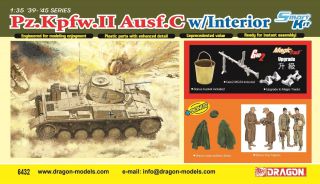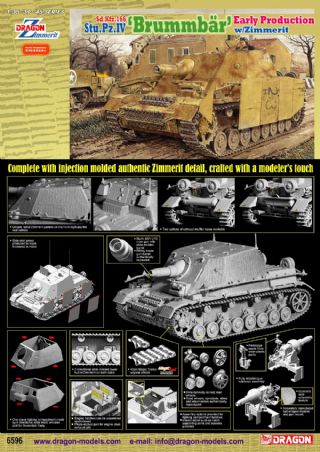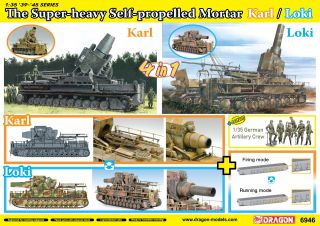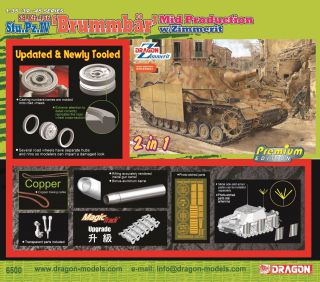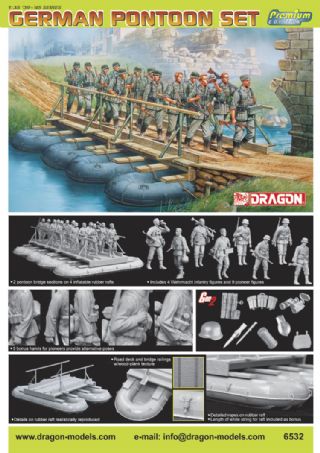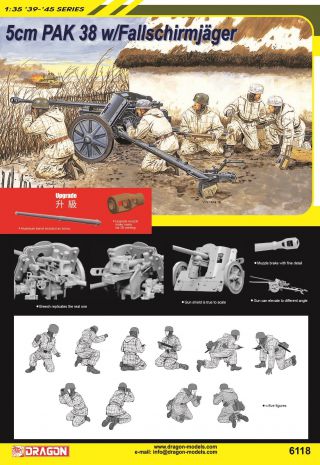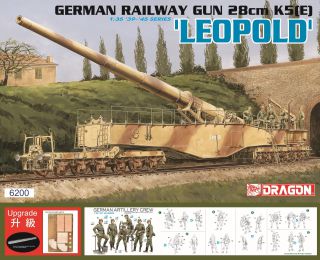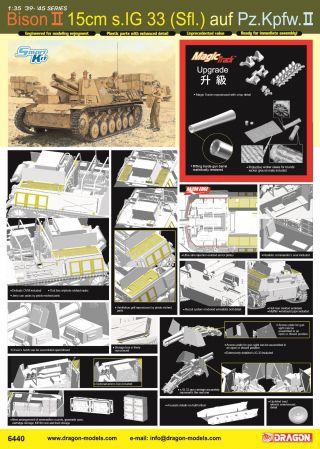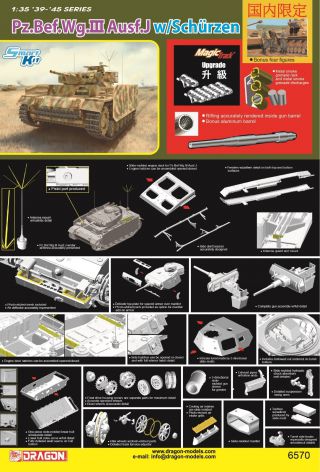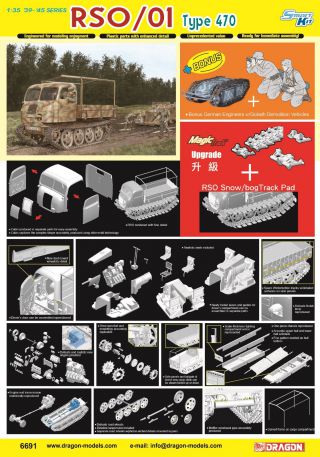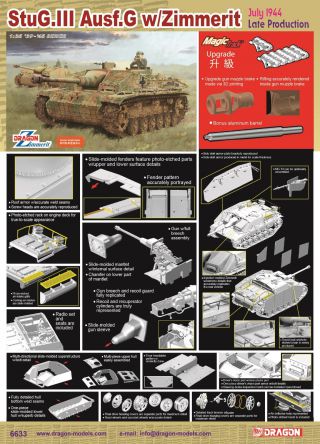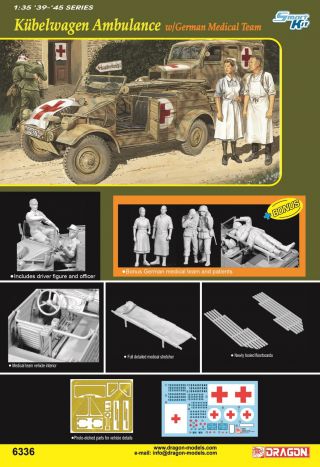HOME → Dragon Plastic Model Kits → 1/35 WWII Military → 6766
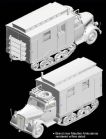

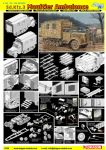
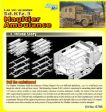
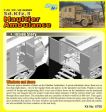
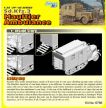



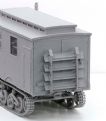







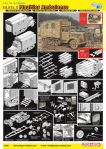
Barcode: 0 89195 86766 7
Case Pack: 20 pieces per master carton
Box Size: 9.6" x 15" x 3.1"
Features:
- Brand new Maultier Ambulance rendered w/fine detail
- Spare wheel mounted on cab roof-rack
- Side doors and rear doors can be assembled open/closed
- Footstep for side door can be assembled up/down
- Rear access steps can be assembled stowed up/positioned down
- Ventilator can be optionally assembled
- Two types of blinds provided
- Stretcher racks provided
- Stretchers can be fabricated in various configurations
- Realistic storage cabinet in interior
- Detailed seats included
- Toolbox included
- Stretcher produced w/crisp detail
- Realistic engine hood formed from multiple parts w/louver detail
- Detailed radiator cover w/filler cap
- Accurately shaped front fenders
- Side-molded engine hood frame
- Two options for door handles can be assembled
- Detailed dashboard and cab interior
- Intricate driver's seat w/realistic cloth pattern
- Fully detailed chassis
- Delicate engine represented
- Intricate fuel tank mounted on chassis
- Sprockets and idler wheels rendered w/accurate detail
- Realistic road wheels assembled from separate parts
- Realistic engine hood covers can be assembled open/closed
- Cab doors can be assembled open/closed
- Includes clear lenses for headlamps and spotlights
- Delicate wheels w/authentic tire tread pattern
- Finely detailed vehicle tools
- Highly detailed Magic Tracks reproduced
- Newly produced optional idler wheels
The 7.1-tonne Maultier, introduced from 1942 onwards, was largely successful although it wasn’t quite as mobile as purpose-built halftracks. One interesting variant was a Maultier Ambulance that could be used for battlefield evacuation. Dragon is proud to be the first manufacturer to offer a plastic kit of this unique vehicle!
This stunning 1/35 scale kit, fully living up to the standards expected by current-generation modelers, is based on Dragon’s existing Maultier. The rear ambulance body is completely new, including a delicate access ladder on the rear, as well as side doors and an associated footstep. The rear door opens to reveal a completely outfitted ambulance interior, one that has been carefully recreated with details as accurate as possible using wartime photos as a reference.
The interior thus includes an elaborate rack for up to nine stretchers, and this rack can be fabricated in a configuration that suits the modeler’s requirements. Indeed, the detailed exterior and interior of the rear body offer unlimited potential to modelers. Previously, only experienced modelers could have attempted to scratch-build such an extensive ambulance conversion, but now Dragon has made this type available to all! For the modeler who wishes to depict a realistic Eastern Front winter scene, this Maultier Ambulance offers something different.
Reviews:
Sd.Kfz.3 Maultier Ambulance
Manufacturer: Dragon Models
Scale: 1/35
Material: Styrene & Etched Brass
Serial Number: 6766
Price: TBA
Dragon:
The famous semi-tracked Maultier, whose name means 'mule' had its origins dating
from 1941 when German troops fighting on the Eastern Front quickly bogged down
in the treacherously muddy conditions at the start and close of wintertime.
Wheeled trucks couldn't handle the tough conditions, so the decision was made
to obtain half-tracked trucks that could negotiate the mud. The rear axles of
standard cargo trucks were replaced with drive shafts connected to track assemblies
from retired Panzer I light tanks. The 7.1-tonne Maultier, introduced from 1942
onwards, was largely successful although they weren't quite as mobile as purpose-built
halftracks. Load capacity was also reduced to 2 tons. Production of some 4,000
vehicles ceased in 1943 in favour of the RSO tractor. One interesting variant
was a Maultier Ambulance that could be used for battlefield evacuation.
The Kit Contents
Dragon/Cyber-Hobby has already released two versions of the Maultier halftrack.
I suspect a lot of people have been waiting for this version. There's just something...something
about it. We don't see many ambulance versions released in plastic from the
main manufacturers, so this one came as a bit of a surprise when it was first
announced. After all, we still haven't seen an ambulance version of the Sd.Kfz.251
even, and we've seen more than a few of them released since the first one!
Many of the sprues have been seen in the previous releases of this vehicle of
course, and yet still there's a surprising number of new ones in this one in
order to allow the modeller to construct the rear body. Given that every area
of this model is fully detailed...including the inside of the rear ambulance
body...then it becomes clear why so many new sprues are necessary. In total
there eight new sprues...although some of them are admittedly small. Some of
them are quite large though! There's a brand new sprue 'L' which supplies the
large parts that go together to make up the actual rear body, there are sprues
'P1' to supply new driver's cab steps and various parts at the base of the cab
to allow the rear body to fit properly, and 'P2', to supply the cabinets that
fit inside the ambulance body, and sprue 'M' for the doors and roof amongst
some other parts. 'N' supplies a host of smaller fixtures and fittings for inside
the ambulance section, with the stretchers being supplied on new sprue 'Q'.
There's a new small transparent sprue included also to provide all the necessary
glazing for the rear body.
Construction begins with the assembly of all the running gear. First off there's
the two front wheels, which we're given new hubs for in this version. They're
identical to the old ones....just supplied on a new sprue as a result of the
old sprue not being included in this version. Once the suspension components
such as front leafsprings, axles and drive train parts are fitted to the slide-moulded
chassis, the suspension bogies for the tracked part of the vehicle can be constructed.
These are well detailed, constructed from multiple parts, with the springs being
injection moulded solid parts. Since these were based on the same Carden Loyd
tankette suspension system that the ones on the Universal Carrier were based
on, and since I've recently reviewed one of those with real springs...you can
probably guess that I'm not exactly over enthused with these ones. Still, they
should look reasonable enough once they're all painted up! The roadwheel tyres
have embossed detail on their sidewalls, and the tracks are all individual link.
There's a new option idler wheel included in this kit, made from three parts
these are of the spoked, solid type, although the other un-spoked solid ones
are still included.
The model has a fully detailed engine too, and we're also given the Opel Blitz
truck engine on another sprue marked as 'not for use'. The engine has a detailed
radiator, fan belt assembly etc., and the bonnet can be modelled opened or closed,
since both open louvered sides are supplied as separate parts, and there's an
etched brass 'Opel Blitz' logo for the front of the radiator. Moving backwards,
the diver's cab is fully detailed of course, with everything as you would expect,
and decals provided for the dashboard dials, and even a separate fuel tank for
below the bench seat. Both cab doors are separate parts, with detail inside
and out, including separate handles, and even window winders. The rack and spare
wheel for the cab roof, both of which are shown on the boxart, are supplied,
yet the full load of Jerry cans in the rack...also on the boxart...are not.
Which I found a bit surprising.
Construction then moves to the rear body, and the ambulance section. This is
constructed from a base laid over cross-members that will be fixed to the chassis,
and onto which separate side, end and roof panels are fixed. There are separate
doors provided for both side panels and end panel, detailed inside and out,
and the roof panel has the large raised centre section with clear glazing. For
inside, the floor panel has rib detail, and the inside of each of each of the
wall panels are fully detailed too. There are cabinets provided for the forward
bulkhead, with various shelves etc, and nine stretchers are provided, to be
held in racks, obviously less could be used as well.
There are two marking schemes depicted on the instructions, one in overall Dunkelgelb,
and one in a three colour camouflages scheme, see below for detail. The decal
sheet included only includes two Red Cross decals, along with generic number
plates and numerals.
Conclusion
This one is going to prove very popular...not only because it's a Maultier of
course, but because it's an Ambulance...which is still sort of rare in injection
moulded kits, but also it has a fully detailed interior...engine, cab and body.
Which therefore offers oodles of potential! Recommended.
-Vinnie Branigan-
Kit Review: Dragon Models Limited ‘39-‘45 Series Kit No. 6766; Sd.Kfz. 3 Maultier
Ambulance - Smart Kit; 716 parts (472 in grey styrene, 197 “Magic Track” single
links, 43 clear styrene, 4 etched brass); pre-order price US$58.95 via Dragon
USA Online
Advantages: all new kit of this popular conversion; first new kit of a box body
for the Opel 3-ton truck; modern, well molded state-of-the-art kit
Disadvantages: single track links nearly HO scale size!
Rating: Highly Recommended
Recommendation: for German softskin fans
As well as the open body cargo variants of the Opel Blitz 3-ton truck, the Germans
also built a large number of closed or “Box Body” variants for various purposes.
The most common of these were long-range radio vans and ambulances. DML has
now released a kit that combines an all new box body for the ambulance variant
with their “Maultier” half-track conversion of the three tonner.
Back in 1999 Italeri released a kit of the cargo truck as a box body with the
“Einheitskoffer” body variant. Now DML has updated that with this body, which
should be a drop fit onto the cargo truck chassis (and comes with wheel wells
to prove it) and will probably be released soon for that version as well. But
this variant is for the ambulance, and DML has provided a full interior for
that version complete with nine stretchers, racks, and fittings.
The interior is complete but as noted rather crowded as once the nine stretchers
are in place there is no room for an attendant or medic to move around. The
racks are quite involved, and as a point of fact this kit adds a total of 196
new parts to the existing molds to replicate the variant.
As with its predecessor Blitz cargo versions this is a typical DML kit of recent
vintage with lots of slide molded parts – and far fewer of them than the armored
vehicle kits. The kit includes a nicely done radiator shell with open bars and
etched brass Opel Blitz badging. It comes with a complete engine and nicely
done hood frame for opening the hood to view the engine. Also the driver’s compartment
is complete with all pedals, levers and “stick-on” instruments for the panel
(A16). Doors have inside and outside handles and separate clear windows.
This kit receives a totally new chassis and suspension, with the multi-piece
tires for the front and a fairly intricate rear suspension. The modeler gets
both early (six bolt) and late (eight bolt) wheels to choose from as well. A
new engine block and crankcase are provided for the modified drive line.
Where modelers will probably start to hate this kit is when they go to install
the tracks. The links are Panzer I links and very tiny – about the size of that
of a medium tank in HO scale (1/87) and very, very petite. Each link is only
6mm x 3mm and there is not much surface for gluing provided, which translates
as ACC cements are not a good idea. I would recommend some combination of Tamiya
Orange and Green or even Testors Liquid Cement on them, and you will need to
make a jig of some sort for best results. DML realy should think of making DS
Plastic tracks for these kits.
Technical support was provided by Tom Cockle and Gary Edmundson.
Two different finishing options are provided for the model: Unidentified Unit,
1943 (sand with green/brown overspray, red crosses, registration plate WH-1618714);Unidentified
Unit, 1943 (sand overall, no markings, no registration plate given). A small
sheet of Cartograf decals is provided.
Overall, this kit expands on DML’s Blitz family and bodes well for other versions
to follow. But as before the tracks will frustrate some modelers.
Thanks to Freddie Leung for the review sample.
-Cookie Sewell-


